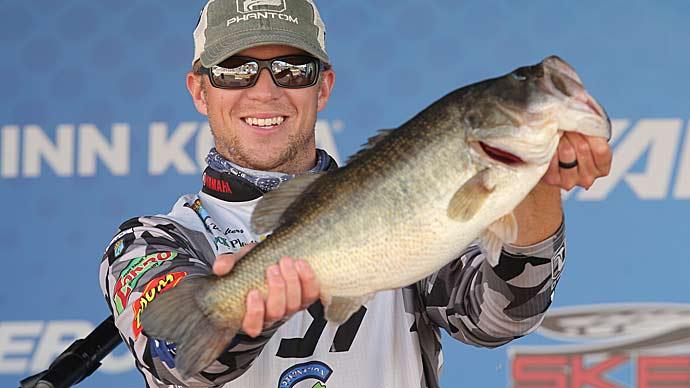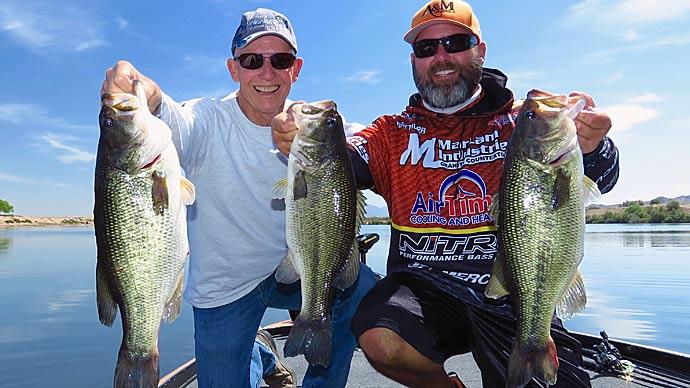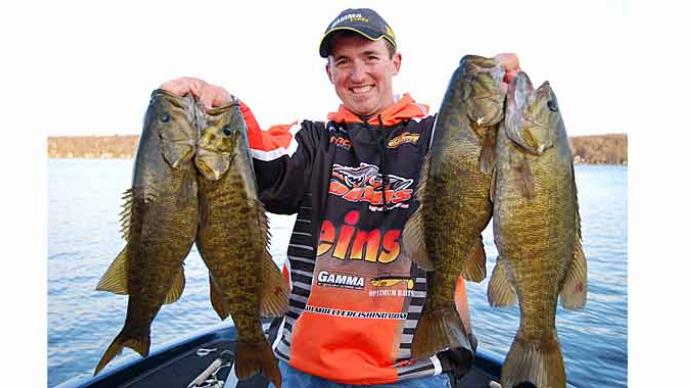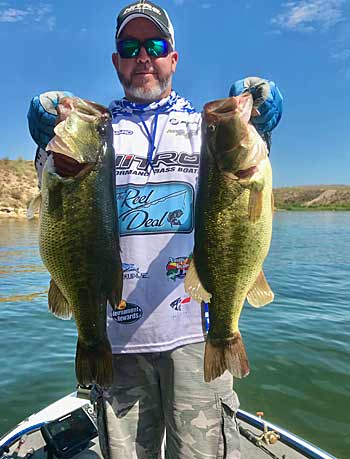
James Howard is both a guide and a tournament angler, so he spends a lot of time on the water on different lakes. Whether he’s guiding or fishing a tournament, the ability to locate willing fish is crucial for success. The key to locating active bass is to cover water with a bait that triggers just about any fish to bite. For Howard, finesse worms do the trick.
Howard’s best-producing worm technique is a flick shake rig with a wacky-rigged Zoom worm. For this Japanese technique, he uses a very small ball head jig in 3/32- or 1/16-ounce, so it floats down very slowly. The slow fall combined with the action from wacky-rigging the finesse worm is very effective at provoking strikes even when fishing is slow.
Gear And Method For Shallow Water
His method is simple. He keeps the boat in about twenty feet of water, casts the rig out, and lets it fall before dragging it back to the boat very slowly. It’s his favorite way to catch finicky fish or put a lot of fish in the boat. He says this is just as effective, or even more effective, than a drop shot. He usually tries to get the worm to hit the water about five feet from shore so it can flutter down. He’ll pop it subtly one or two times, just jiggling the rod tip, so it flutters on the way down and on the way up.
The problem that some people encounter with this method, he says, is that they can’t feel the bottom and have a hard time picturing what the lure is doing. He says you're doing it right if you keep fluttering the rod tip and letting the rig fall until the line goes slack. When the worm is underneath the boat, it’s time to re-cast.
This flick-shaking technique calls for an ultralight spinning rod. He uses 10-pound-test braid with a six- to seven-foot fluorocarbon leader tied to the braid with an Alberto knot, so it slides right through the rod guides. This method doesn’t call for long casts because the rig is light. His clients say it’s weird because they can’t feel the lure but can feel the bites.
Howard keeps weedless versions of the tiny jigs on hand so he can fish them around and between trees and on rocky banks and riprap. Shallow flats are ideal for this rig – deeper flats and points take a long time, so he focuses on the shallower flats and around tules. He lets the rig flutter down on banks and riprap until the line goes slack, then gives it a gentle pop and lets it stair-step down to the next level. He fishes this technique in twenty feet or less.
The main problem he encounters with clients is that they often fish much too fast if they aren’t seasoned fishermen. “If you don’t slow down, you aren’t going to catch any fish,” he says, “so I show them how, I don’t just tell them.”
Becoming A Guide
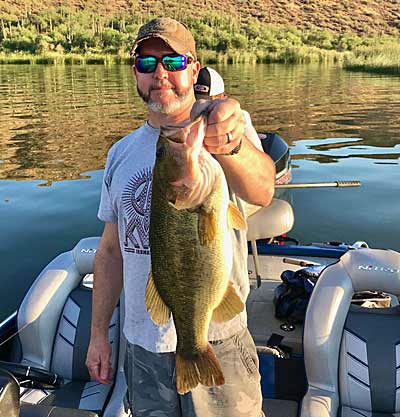
Howard grew up in Michigan fishing for perch and bluegills and trolling the big lakes for walleye. When he moved out to Arizona, he started fishing on Tempe Town Lake with spinnerbaits and crankbaits and caught his first bass – a 3-1/2 pounder – on a crankbait. A buddy of his took him to Bartlett Lake, and before long, he was hooked on bass fishing and bought a 14-foot Bass Tracker with a 40-hp motor.
Initially, guiding was a lot of pressure. At first, he’d find random people and take them fishing for free just to see if he could put them on fish, which worked well. The worst thing, he says, is those who can’t seem to slow down and insist on cranking the lure back to the boat. Those people never catch anything.
He tries not to schedule weekends when the lakes are so busy, but he’ll make trips on Fridays. Usually, he says, by the time the boat traffic gets bad, they’ve already gotten a bunch of fish in the boat just by giving those flick shake worms a couple of little twitches and then letting them fall. The beauty of this technique is that it works all year long.
Fishing Deeper
In addition to the flick shake gear, Howard says he always keeps drop shot tackle and small swimbaits on board. The swimbaits he prefers are the 3- to 4-inch paddle tail baits by Arizona Custom Baits, fished on VMC Moon Eye jigs. With a dark and a light color, he can match the hatch on any lake he fishes. Those colors are white with silver sparkle and glitter shad – a gray and black bait with rainbow sparkles.
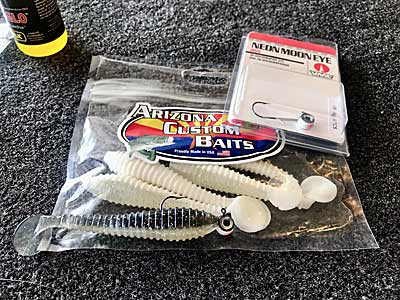
He’ll always try swimming the paddle tails first, but on a bluebird day, he usually has to slow down and fish it like a worm, letting the bait sink to the bottom and then slowly retrieving it. Another favorite retrieve is to cast it out, let it hit bottom, pop it, hit bottom again, crank two or three times, then pop it again. “I yo-yo it off the bottom just like fishing for walleye,” he says, “working it back to the boat.” The fish are usually on the bottom, but suspended fish are harder to catch. He’ll vary his retrieve for suspended fish, swimming and popping, or even steadily swimming the bait. He says you have to try different things until you get bit. These little swimbaits are great for kids because they usually don’t have the patience to fish a flick shake or a drop shot.
With a drop shot, the biggest problem is the line twist, and Howard has some horror stories about that. He gets past it by using the smallest barrel swivel he can find to the main line, then attaching the leader to it with another tiny clasp swivel. With this “double swivel” set-up, he’s never had a line twist problem. He ties a bunch of leaders up ahead of time with the clasps already on them, and he can pull them off and re-use the hardware.
The problem with this is that you have to leave those leaders outside the guides when you cast, which is a problem for many clients. In those cases, he’ll use the Alberto knot to attach a fluorocarbon leader to braid. Straight fluorocarbon, he says, is a line twist nightmare. He gives his clients the lightest weight they can fish with, usually 1/8-ounce, but if they have trouble counting rocks, he’ll up them to ¼-ounce.
Drop Shot Tips
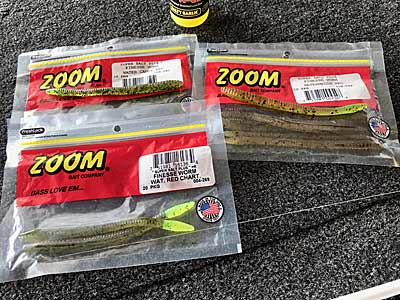
Nitro Pro Matt Shura says drop shot rigs and spoons are perfect baits for under the boat. Watch the graph for great structure or a school of fish and drop it down to them. If the water is super cold, just let the bait sit there – the water will make it move enough to get the fish’s attention. Giving your drop shot a little slack makes a considerable difference in the action, but very few people do it. You can fish a drop shot all day and never feel the bite, so Howard says to pick up on the bait slowly once in a while. If you feel any weight, set the hook by pulling up on the rod and reeling simultaneously.
Fall is a great time to start fishing a drop shot rig when the water temperature gets to about 60 degrees. Look for points that come out into deep water, especially with rock piles, trees, or boulders. Anything different will hold fish. Watch the graph. If you see fish, cast past them and let them drop shot ease over them. If there is brush that the hook can get snagged on, rig the worm Texas but still on the drop shot rig.
An old-timer at Roosevelt showed me how to use two hooks and rig up a Tight liner Drop Shot Rig. Use a 3/16-ounce pea head at the bottom with a curl tail worm, a mosquito hook about two feet up from the jig, and a mosquito hook about two feet up from the jig with a straight finesse worm on it. He said over three years of using this rig, about 55% of his fish came on the jig head at the bottom, and the rest took the drop-shot worm up top. Seriously, this guy keeps impressive records. He says you might catch twelve in a row on the bottom, then the next seven on the top worm.
If you’re fishing heavy cover and the fish won’t eat off the bottom, try using a heavy-line drop shot rig instead of Texas. Use 10- to 12-pound test line and a baitcasting rod with a ¼-ounce weight. Tungsten is excellent in heavy cover because it’s so much smaller -- you get fewer hang-ups. With a Carolina rig, the bait falls to the bottom, but with this heavy line drop shot, you can keep the bait in the strike zone even in heavy cover. A Mojo or cylinder weight works well, too, particularly in tules. Your leader can be as short as three inches in shallow water. If there is a lot of silt on the bottom, a three-inch leader may leave your worm on top of the mud. Don’t be afraid to experiment.
Howard has learned from guiding that no matter how tough things are, you can usually catch a few fish if you are patient enough to fish slowly when you need to. Slow down if you aren’t catching fish – it can make a huge difference.
BassResource may receive a portion of revenues if you make a purchase using a link above.


